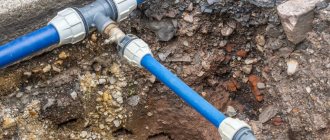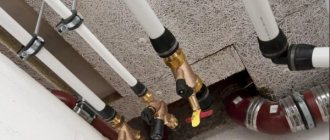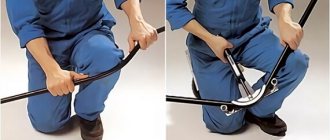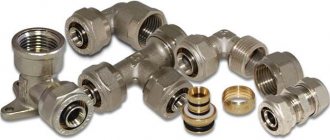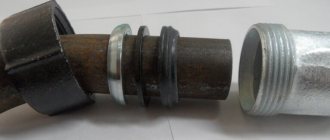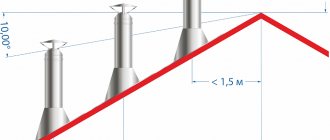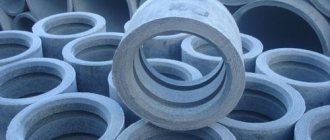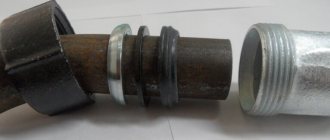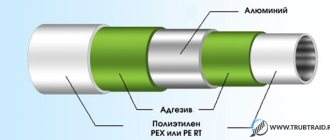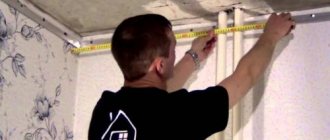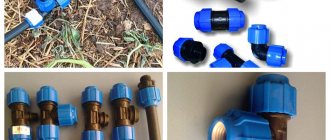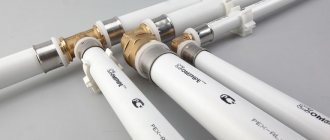In most cases, metal-plastic pipes are connected with fittings (couplings). A fitting is a special element that serves to connect and branch pipes, and also serves as an adapter to another pipe diameter. On a non-industrial scale, it is easier and much cheaper to use factory fittings, while using technologies adapted for private owners.
This is exactly what we will talk about. So, the following types of couplings are used to connect metal-plastic pipes to each other:
- compression;
- press fittings (slide-in press fittings).
If it is necessary to connect pipes made of different materials or metal-plastic having different diameters, then collet fittings are used.
The list of necessary tools depends on what type of coupling you have chosen for the connection. It must include two adjustable wrenches for greater convenience.
Design and characteristics of metal-plastic pipes
The internal and external parts of these products are made of plastic, due to which the design is highly resistant to negative factors.
Between these parts there is a reinforcing layer, which is aluminum foil. Glue is applied to both sides. It securely fixes it between the plastic layers. On the one hand, such a device provides flexibility to the product, but multiple bends in one place are not allowed. The reinforcing layer is overlap welded using ultrasound or butt welded with a laser. Pipe products with a connection according to the first option are characterized by uneven geometric parameters, and for this reason they suffer in strength. Products butt welded using laser technology are called seamless. They have uniform thickness along their entire length, are more reliable, but also cost more.
The aluminum layer has practically no effect on the main operational parameters of the pipeline. Her tasks are the following:
- providing partial compensation for polymer expansion when heated;
- creating a diffusion barrier that prevents oxygen from entering the pipe.
Since the liquid moves through the plastic layer, it is this layer that forms the operational properties of metal-plastic pipe products.
Good to know! Both layers - inner and outer - are made from cross-linked polyethylene. Moreover, for metal-plastic water pipes an expensive type of this polymer is used - food-grade polyethylene, while for the sewerage pipeline it is cheaper.
A metal-plastic pipe is a multilayer product, inside of which there is a reinforcing layer.
Water hammer may occur in water supply systems. Pipe products, marked with the following symbol sequences: PEX and PE-RT, cope well with them. But for the installation of water supply branches in which the likelihood of water hammer occurring is high, it is better to avoid metal-plastic pipes marked PE-RS, PE-HD and HDPE - they operate at low pressure.
Among the advantages of these products it is worth highlighting:
- ease of installation;
- high chemical resistance;
- environmentally friendly materials are used for production;
- flexibility makes it possible to bypass irregularities and corners, which in some cases reduces the relevance of connecting metal-plastic pipes with fittings in limited space. They can simply be bent;
- scale does not form on the inner surface;
- not subject to corrosion;
- long service life - up to 50 years.
But there are some drawbacks here too.
The main ones are:
- exposure to ultraviolet radiation causes “aging” of metal-plastic pipe products;
- Such products are subject to combustion.
Design Features
Metal-plastic pipes have a multilayer structure, which consists of 5 separate layers that perform different functional tasks:
- outer and inner layer of polyethylene;
- intermediate reinforcing layer of aluminum foil;
- shells made of aluminum and PE are connected by two layers of adhesive that is resistant to high temperatures.
For the manufacture of metal-plastic products, two types of polyethylene can be used - PEX (cross-linked polyethylene) and PE-RT (thermal stabilized polyethylene). These PE modifications differ in manufacturing technology; in practice, the differences between them are that PEX is more resistant to deformation during long-term heating, which makes PEX pipes the preferred choice when installing underfloor heating and hot water supply systems.
The foil shell, lying between the inner and outer PE layers, ensures zero vapor permeability of the pipes, which, in turn, minimizes problems with corrosion of heating devices (boilers, radiators) due to the penetration of oxygen into the coolant.
Metal-plastic pipes can be used in the following systems:
- cold and hot water supply;
- radiator heating;
- warm floor;
- pipelines for gas supply.
The operating temperature maximum for metal-plastic products is +90 degrees; they are able to withstand operating pressure of up to 20 MPa .
Tool for cutting metal-plastic pipes
Metal-polymer pipes are produced in the diameter range of 16-53 mm. Products with a diameter of more than 40 mm are practically never found in household use, while segments up to 32 mm are most in demand. The cheapest and most commonly used are 16 and 20 mm metal-plastic pipes, the cost of connecting fittings for which is minimal.
The wall thickness can be from 2 to 3.5 mm, the maximum bending radius is 80 mm (when bending manually) and 40 mm (using a pipe bender).
Advantages of metal-plastic pipes
The advantages of metal-plastic products that distinguish them from polymer analogues include:
- Ideally smooth walls (roughness coefficient 0.006), which guarantees quiet water supply and no problems with traffic even after a long time of operation.
- Full resistance to corrosion and chemically aggressive substances.
- High mechanical strength, resistance to bending and tensile loads, crack resistance.
- Minimum weight, low cost of the pipes and connecting elements themselves, the pipeline is extremely easy to install with your own hands.
- The products bend easily and, due to the aluminum layer, perfectly hold the given shape.
- Durability – product lifespan exceeds 50 years, and maintainability.
- Aesthetic appearance - after installation, the pipeline does not need to be painted.
Among the disadvantages, we note the tendency of the material to linear expansion. To prevent problems associated with it, the installation of metal-plastic pipes must be carried out in compliance with a number of rules, namely:
- For fixation, you cannot use rigid fasteners, since when clamping an expanding line, the tension in the material increases greatly; sliding clips must be used;
- It is important to observe a step between the clips of 40-60 cm, which does not allow the pipeline to sag between the fasteners.
In general, in terms of overall performance qualities, metal-plastic pipes are superior not only to metal ones, but also to most polymer analogues.
Basic rules for installing metal-plastic pipes
Metal-plastic pipes are highly sensitive to mechanical damage, temperature influences, and do not tolerate direct exposure to ultraviolet rays. Therefore, open laying of metal-polymer pipes is possible only in those places where the presence of these factors is excluded.
In order to easily repair concealed metal-plastic pipes with screw fittings, it is necessary to provide inspection hatches at the joints. These elements should not have sharp edges.
Metal-plastic pipes are laid through building structures using sleeves. There should be a gap of 3-5 mm between the inner surface of the sleeve and the outer side of the pipe, which is created using a soft, non-flammable material that allows longitudinal movement of the pipe.
At all stages of pipe laying, it is necessary to remember that the formation of cracks, cuts and scratches on the surface is unacceptable.
Therefore, sharp objects should not be used when unpacking pipes. Marks can only be drawn with a marker or pencil.
For the installation of press fittings, reliable equipment is used, which eliminates the creation of poor-quality connections.
Installation of metal-plastic pipes - video materials will help you cope with this process - should be carried out using hangers and supports offered by pipe manufacturers. When using metal fasteners, the pipe is protected with gaskets made of soft materials.
To solve the question of how to repair a metal-plastic pipe, you can choose one of the options:
- to eliminate a leak, it is necessary to cut out a piece of pipe and install a new one using a connecting fitting;
- if the leakage area is small, you can install only a connecting fitting without buying a new pipe;
- The leak can be sealed by installing a flange with a gasket or sealed with epoxy glue or sealant.
Metal-plastic pipes are the most versatile among polymer pipes; they are reliable in operation, easy to install and have an aesthetically attractive appearance. It is these properties that explain the growth of their popularity.
Press fittings
The connection of metal-plastic pipes of this type is used very often. Such fittings are used both in water supply and heating systems. Press fittings, like compression fittings, are made of brass.
Advantages and disadvantages of pressed joints
Slide-on press fittings have the following advantages:
- ensure reliability and durability of the connection in the absence of vibrations and shifts;
- they do not require periodic inspections;
- they can be safely walled into walls and used for laying “warm floors”.
Flaws:
- for their installation you need a special tool, as well as the ability to work with it;
- press fittings cannot be reused, which complicates the problem of disassembling and assembling the system in the event of its partial failure or the need to replace (adding) individual elements;
- If the connection is installed poorly, it will leak and the fitting will need to be replaced. Without work experience this is problematic.
Installation of pressed connections
Metal-plastic pipes are connected to press fittings in the following order:
- The pipe is cut to the required length using special scissors. The edges will wrinkle in any case; you need to give the cut area the correct shape. It is better to do this from the inside by placing a solid conical object into the pipe.
- Then you need to remove the internal chamfer from the pipe. This can be done with a special tool - a bevel remover.
- The external chamfer is removed.
- The internal diameter of the pipe is checked by a calibrator.
- Then the quality of the fitting is checked. To do this, you need to remove the sleeve from it and check the gaskets and connection rings. After this, the sleeve is inserted back.
- Insert the pipe into the press fitting until it stops. It should be clearly visible in the sleeve hole.
- Crimp the coupling using press pliers (this can be done either manually or electrically).
To eliminate the process of electrical corrosion, you need to insert a dielectric gasket at the junction of the fitting with the end end of the pipe.
Below watch a detailed video about the design and installation of press fittings:
How to properly connect metal-plastic pipes
To connect these elements of the water supply branch, special press fittings, compression parts and push-in press fittings are used. Let us consider the method of their installation in more detail.
Compression fittings are convenient and easy to use, they can be used more than once
Compression parts. In this case we are talking about the use of crimp brass fittings. To connect the elements of the water supply branch with their help, it is enough to have a wrench. The design of the part includes a union nut, a fitting and a split ring. Compression fittings can be disassembled and also reused.
Even a person with only basic plumbing skills can cope with the task of connecting metal-plastic pipes using this technology. The sequence of events is as follows:
- First, a pipe of the required length is prepared. The main requirement is as follows: the area of the workpiece at a distance of 10 cm before and from the cut site must be level;
- then the workpiece is cut according to the markings using precision scissors. In this case, the cutting plane must be strictly perpendicular to its longitudinal axis;
- after checking the integrity of all parts and gaskets, put a nut on the pipe, and then a ring from the fitting;
- the edge of the workpiece is processed using a reamer. Using the calibration side, the internal chamfer is removed by 1 millimeter. The other side is the external chamfer;
- the pipe is pushed onto the fitting until it stops;
- The union nut is screwed onto the fitting, first by hand and then using a wrench. Ultimately, 1-1.5 turns of thread should remain visible.
Advice! Tighten the nut very carefully. If you apply too much force, the ring may crack.
It is this factor that determines the presence of one feature in such a collet connection of metal-plastic pipes. It consists in the need to periodically tighten the union nut.
If there is a need for hidden pipe laying, then press fittings should be used for their installation.
Special press fittings. These connecting elements are used when laying hidden communications and when installing heated floors. The work is carried out using a tool called press tongs. Installation in this case is more reliable than when using compression fittings. The connection is made in the following order:
- the pipe is cut. The edge is calibrated by chamfering, both external and internal. The pipe diameter is controlled using a calibrator;
- the fitting is checked for the presence of o-rings and a dielectric gasket;
- a crimp sleeve is placed on its edge;
- O-rings are put on the fitting, after which the fitting is inserted into the pipe;
- During the process of crimping the coupling using press pliers, it is necessary to control that the sleeve collar fits into the recess on the press nozzle. This tool is equipped with inserts suitable for working with pipe products of different diameters. It is not advisable to repeatedly crimp the coupling; you need to act in such a way that you get a positive result the first time.
There are press fittings on sale, the coupling to which is already attached. This technical solution allows you to immediately place the part on the pipe. The seating depth is controlled through the hole in the coupling.
Slide-on fittings. Such a connector for metal-plastic water pipes is fixed not only with the help of press pliers. In this case, it is also assumed that an expander will be used to expand the diameter of the pipe to a size that allows reliable fastening of the fitting. The result is a permanent connection. It is used when constructing a hidden pipeline.
The sliding fitting provides a permanent connection, and can also be used for hidden wiring of communications
The answer to the question of how a metal-plastic pipe is connected to a fitting of this type begins with a standard phrase: first we prepare a piece of the required length. Then we put a coupling on it, after which we expand the edge of the pipe with an expander. Then the fitting is put on, the coupling is clamped with a press, and the fitting on the fitting is tightened. Such actions will ensure a reliable and tight connection.
Tools
The set of tools for installing metal-plastic communications depends on what fittings are used to connect the parts of the pipeline.
To assemble a pipeline from metal-polymer pipes you must have:
- pipe cutter or hacksaw for cutting material;
- calibrator - to expand the pipe and give the circle ideal proportions;
- chamfer - for chamfering;
- sandpaper to remove burrs on the edges of the pipe;
- adjustable (or wrench) wrenches;
- press jaws for some types of connections;
- a heat gun or bending device such as sand.
It is preferable to do the cutting with scissors, but you can also use a hacksaw or a sharp knife.
Note! Due to the application of physical pressure on the pipe, the cut becomes oval and has burrs. To eliminate defects, use a calibrator, chamfer remover or sandpaper.
When the edges are ready for connection, the pipe is inserted into the fitting. There are several types of connecting metal-plastic pipes to each other or with a transition to another material:
- compression fittings;
- press connection;
- push fit.
Compression connection of metal-plastic pipes
In private construction and agriculture, compression joints are most often used. This is done using special PE fittings with a press-fit sleeve.
You don't need a special tool to make the connection.
Fittings with a diameter of 2-5 cm are installed manually. For larger sizes, a chain wrench is used. Wrenches can also be used to tighten fittings.
The compression technology for connecting pipes involves:
- Pipe cutting. You need to cut at a right angle using plumbing shears for metal, technical scissors for cutting polymer pipes.
- Cleaning pipes, removing burrs and rounding edges. The surface that will be inserted into the fitting must be clean and free from defects. Otherwise, the pipe may, over time, begin to leak. Installing the blue nut. The blue nut is removed from the fitting and placed on the pipe.
- Installing the white clamp ring. Installation is carried out with the thickened end of the part towards the long end of the pipe.
- Fitting installation. The element is put on the pipe and the metal crimp ring is pushed until it stops.
- Tightening the blue nut. It is better to tighten the nut first by hand and then using a tool.
The disadvantages of compression connections include the fact that after some time they have to be pulled. At the same time, stretching fittings can be very difficult. Especially if communications are located under the floor. Otherwise, the base will have to be dismantled to carry out the work. To avoid broaching, press fittings should be used for connections.
How to connect metal-plastic pipes using press fittings
Press fittings are special devices for connecting plastic pipes, which are characterized by high strength and durability, comparable to the service life of the water supply system itself. A press fitting consists of a body with a fitting and seals that isolate the ring and ferrule. Thanks to this design, the fitting does not leak. Today there are a large number of press models that allow you to implement any pipe layout.
Press fittings are installed quickly and easily using a special tool - crimping pliers.
Pincers can be either manual or hydraulic. Before you go shopping for a tool, you should determine the diameter of the pipes.
In order to connect two metal-plastic pipes with a press fitting correctly, you need to:
- Cut the pipe at the desired location at a right angle.
- Adjust the diameter of the pipe and remove the chamfer using a chamfer tool.
- Place a stainless steel sleeve on the end of the pipe.
- Insert the fitting into the fitting pipe.
- Grab the tension sleeve with pliers and bring the tool handles together until they stop.
You should work carefully, since it will be impossible to re-crimp the fitting, and due to a poor-quality connection, the pipe may begin to leak. Then you will need to repair the metal pipe.
Fitting device for metal-plastic pipes
High-quality installation is impossible without the correct connection of the pipe with the fitting. To understand the principle of their connection, it is necessary to study the design of the compression fitting.
It consists of three parts - a body (on one side of which there is either a threaded connection or a fitting, and on the other there is a fitting with rubber ring seals), a ferrule nut and a cone ring.
It is these three elements that ensure the tightness of the connection. This connector works quite simply - as the nut is tightened, the ferrule compresses the pipe, forcing it to tightly and forcefully fit the fitting with the rubber seal.
Types of fittings for metal-plastic pipes
The structure of metal-plastic pipes is such that it is impossible to weld or solder them. Therefore, all branches and some bends are made using fittings - special elements of different configurations - tees, adapters, angles, etc. With their help, a system of any configuration can be assembled. The disadvantage of this technology is the high cost of fittings and the time that will have to be spent on their installation.
An approximate range of fittings for installing metal-plastic pipes with a press
The advantage of metal-plastic pipes is that they bend well. This allows you to use fewer fittings (they are expensive). In general, fittings for metal-plastic pipes are:
- Crimping.
- Press fittings (press fittings).
Deciding what type of fittings to use is easy. Crimping ones are used for pipelines that are always accessible - connections need to be tightened over time. Pressed ones can be walled up. That's the whole choice - you need to know what type of installation of metal-plastic pipes will be in a specific area.
Appearance of some fittings with union nuts - screw or crimp
A common disadvantage of metal-plastic pipes is that due to the design of the fittings at each connection, the cross-section of the pipeline becomes narrower. If there are few connections and the route is not long, this cannot have any consequences. Otherwise, either an increase in the cross-section of the pipeline or a pump with more power is necessary.
Working with metal-plastic pipes - calibration
Lightly moisten the fitting fitting with water and place the pipe on it. You need to pull it until the very end, until the pipe rests against a small white ring. If you do not insert the pipe all the way, the chances that it will be torn off during operation increase several times. At this stage, you should check the evenness of the cut - if the pipe rests against the white ring evenly on all sides, then everything is in order.
If there is a gap of more than a millimeter on either side, then it is better to remove the pipe and cut its end again, since such a connection can lead to a leak.
Connection of metal-plastic pipe and fitting
If everything is connected normally, then you can move the nut as close to the fitting as possible and, using adjustable wrenches, tighten it with all the force until a characteristic creak or squeak appears.
Don’t be afraid to pull - if the fitting is of high quality, the nut will withstand any load. If it bursts, that's even better. You will get rid of low-quality spare parts, the operation of which could lead to a flood.
Push-in connection of metal-plastic pipes with fittings
Push-in fittings are special connecting devices that have two rubber seals in their design. Thanks to this, a tight connection is achieved. These connectors are made of brass, which makes the fittings resistant to corrosion.
Push-in fittings have a special dielectric gasket in their design, which makes them electrically non-conductive.
Even beginners can install the devices. The design of collet fittings requires the presence of a special ferrule, which allows clamping evenly without deforming the structure. After all, it is quite difficult to straighten such a pipe with defects.
There are several types of collet connectors:
- Angle for metal-plastic pipes (internal - B type and external - H type);
- Straight fitting (allows you to connect pipes in series);
- Tee (can connect three pipes together either in series or at right angles).
The push-in connection is made using clamping pliers. You can also use a special press for fittings. In this case, the pipes should be well flared before joining.
Slip-on fittings
This connector consists of a fitting and a sliding plastic sleeve. It is pressed onto the pipe, squeezing it. An expander is used to expand the pipe. The procedure is as follows:
- A plastic sleeve is placed on one of the pipes.
- The second section of pipe is flared using an expander.
- Insert the fitting until it stops.
- Slide the sleeve onto the fitting and press it into place.
The tightness of the joint is ensured due to the ability of polypropylene to return to its original state due to its elasticity.
Push-fit connection
Push fittings are the most expensive elements for connecting metal-plastic pipes. However, their use does not require any tools or skills, and is reliable and durable.
The prepared pipe is inserted into the push-fit until the control hole. Next, the entire structure is assembled. A test flow is started, under the influence of which the connection is secured with an internal wedge.
Wall mounting
The weak point of metal-plastic products is their low resistance to mechanical damage due to the fact that the aluminum layer is thin.
With a large bending radius or constant pressure, the pipe is deformed. In this case, it is recommended to fix the pipeline on a solid base - a wall, ceiling or under the baseboard. To do this, a fixing element is mounted into the wall:
- clips;
- supports;
- pendants.
The process of fastening and fixing occurs using a simple method:
- the support is attached to the wall and fixed in a stationary position;
- The pipe is inserted into a clip with a release mechanism. If the clip is blind, then a pipe is initially inserted, and then the entire structure is attached to the wall.
When fastening, be sure to use soft spacers between the fastening element and the pipe.
Fastening metal-plastic pipes to the surface
When working with metal-plastic pipes, you need to know how to mount them to the surface. To secure the pipes you must use special clips. They are selected taking into account the size of the pipe itself. First you need to install the clip. Its fastening is carried out using self-tapping screws or dowels. To avoid sagging of the line, the distance between adjacent clips should not exceed one meter. Pipe bends must be secured on both sides.
To avoid sagging of the pipeline, the distance between adjacent clips should not exceed 1 meter. The turn of the highway in the corner of the room must be fixed on both sides
VALTEC compression fittings for metal-plastic and PEX pipes
VALTEC VTm.300 compression fittings are designed for connecting metal-plastic (metal-polymer) pipes, as well as for connecting these pipes to pipeline fittings. The materials for their production are plumbing brass CW617N (body, union nut), synthetic rubber EPDM modified with hardening additives (seals), PTFE (dielectric gasket).
The advantages of connectors over products from other companies are higher throughput, temperature resistance, mechanical strength, reliability of connections, provided by the design features of the products, manufacturing technology, and materials used. The nickel coating prevents corrosion of brass and leaching of zinc. A crimping ring (“cracker”) made from a pipe does not damage the outer layer of the pipe during the crimping process. There is a Teflon dielectric gasket, two O-rings, a housing area for a wrench, and a collar that limits the entry of the thread into the mating connector. Installation of compression fittings requires a minimum set of tools (a pair of open-end wrenches, a calibrator-beveler). Connectors can be dismantled and reused.
The maximum operating temperature for using fittings is 115 °C; nominal pressure – 25 bar. Compatible sizes of metal-plastic pipes: 16x2.0; 20x2.0; 26x3.0; 32x3.0 mm.
Compression fittings for metal-plastic pipes
Compression fittings for metal-plastic pipes are connecting elements of the pipeline. They allow you to create fairly strong connections without the use of special tools, and the tightness of the installed plumbing system is ensured by O-rings and gaskets. You can order compression fittings produced by Valtec of the required varieties and in any quantity right now on the website tdsayany.ru.
Features of compression fittings
Connections using compression fittings (collet-type connections) require neither threading nor welding. These elements may have one or two sealing rings. They are made from various materials and connect pipeline sections quite firmly, creating a single unit. Sealing, as mentioned above, is ensured by O-rings. During operation, repeated dismantling and installation is possible. Compression fittings for metal-plastic pipes are used in pressure systems. During installation, only a calibrator (for chamfering the end) and 2 open-end wrenches are required.
Types of Compression Fittings
Crimping fittings are divided into two main types: – straight – for connecting two sections of a system made of the same material and with the same diameter; – transitional – for connecting pipeline sections made of different materials or with different diameters.
By design, compression fittings for metal-plastic pipes are divided into: • couplings – used to connect two equal-sized sections on a straight section of the system; • corners – used when changing the direction of the pipeline by 45, 90, 120 degrees; • tees – used when it is necessary to divide the system into two branches; • crosses – used when dividing a pipeline into three branches; • plugs, plugs, caps – used for hermetically sealing ends; • fittings – for connecting a pipe and a hose.
Connections made with compression fittings are serviceable and are therefore not usually suitable for installation in walls or under floors.
Valtec fittings
Valtec crimp connectors compare favorably with connectors from other manufacturers in a number of ways, for example:
– ability to pass water 8-12% more; – in the production process of the body and union nut, CW617N brass and hot pressing method are used; – channel geometry has been optimized (to increase permeability); – instead of a rubber ring, a ring made of ethylene-propylene-diene monomer is used; – not one, but 2 rings are used for sealing; – the design is supplemented with a Teflon gasket (so that the aluminum fittings do not come into contact with the brass); – the crimp ring is made from a pipe (from other manufacturers – from tape).
Valtec compression fittings can be used for cross-linked, polyethylene and heat-resistant polyethylene systems where metal-plastic pipe requires connecting elements. There are fittings for products with a diameter of 16, 20, 26, and 32 mm. They can withstand pressures up to 25 bar and temperatures up to 130°C.
For installation of communications made of Valtek metal-plastic materials, the manufacturer recommends using connecting parts and tools from the same company. When using tools from other manufacturers, the quality and tightness of the system at the joints is not 100% guaranteed.
Non-standard connection options
It may be necessary to connect metal-plastic parts of communications with pipes made of a different material or switch to a different diameter.
For this purpose, special fittings are used. Both compression and press adapters are available for sale.
For connection, it is necessary to select the correct adapter of the appropriate diameter with internal thread. In this case, the external thread is cut on the pipe itself. To make the joint more durable, various sealants are used: flax fibers, fum tape or special paste.
How to connect metal-plastic and metal
The connection of metal-plastic pipes and a metal pipeline is necessary when installing wiring from a central main line or, for example, when installing an individual heating system. Here, the metal-plastic-metal connection is made when connecting the piping to the water heating boiler.
We recommend that you read: Correspondence when installing the diameters of steel and polypropylene pipes
The connection of metal-plastic with a steel pipe is carried out with special transition fittings. One end of such a part is intended for metal-plastic and can be either compression (with a nut on the thread) or crimped on a press washer. The second end of the fitting has a metal thread. It can be both internal and external.
Installation is carried out by connecting the steel pipe to the fitting. To seal a threaded connection, use winding tow on drying oil and fum tape. Then the metal-plastic part of the communications is attached.
Features of connecting metal-plastic pipes and polypropylene pipes
To install metal-plastic and polypropylene pipes, special fittings are used - on one side, such a part has a polypropylene part intended for welding with polypropylene material. The second part of the part is a press fitting with a sliding press sleeve or with a press washer on the thread.
Work begins by soldering the fitting to the polypropylene pipe. After the welded joint has completely cooled, metal-plastic is attached.
Note! Manufacturers of plumbing equipment offer fittings of various configurations, which allow you not only to connect dissimilar pipes, but also to switch to a different diameter and mount an outlet for tapping.
Compression fittings
Compression or crimp couplings are usually made of brass. They have a simple design consisting of only three parts:
- a fitting shaped like a truncated cone and inserted into the pipe. For different pipe diameters, of course, fittings of different diameters are selected;
- split ring;
- union nuts, also of established diameters.
Despite their simplicity, compression fittings are able to provide a reliable connection of pipeline elements. Moreover, for this you only need a wrench of the appropriate size.
Compression couplings differ from each other in the following ways:
- the outer diameter of the pipes that need to be connected;
- type of thread on the fitting itself.
Operating principle of crimp connections
The fitting is inserted into the pipe until it stops (it is not necessary to use maximum force). The union nut of the coupling is tightened with a wrench, which compresses the press sleeve (sleeve ring) located on the pipe. The more you tighten the nut, the greater the tightness between the pipe and the coupling fitting will be, since the cone goes deeper into the pipe - the difference in diameters plays a role.
Please note that to connect each subsequent element of the pipeline, it is sometimes necessary to hold the union nut on the previous one; it is in this work that you will need a second union wrench. In autumn, it often happens that a previous tightly clamped connection is loosened if operations are carried out on a subsequent element without holding the adjacent connection.
Advantages and disadvantages of compression joints
Pros:
- ease of installation;
- no special expensive tools or professional skills to work with the material are needed;
- couplings of this type can be reused, that is, all connections are disassembled and reassembled with other or the same pipes.
Minuses:
- installation takes quite a long time;
- this connection requires periodic checks and may leak;
- do not undertighten or overtighten the fittings - this will lead to leaks in both cases;
- If collet fittings are used, they cannot be walled up.
The process of connecting metal-plastic pipes with crimp couplings
The technology for installing compression fittings looks like this:
- First you need to align the pipe so that the straight section is more than 10 centimeters on both sides of the cut. It is not recommended to attach connections to curved ends; this can cause internal distortion and uneven tightening, which will ultimately lead to leakage or even play at the connection point.
- Next, the end is cleaned so that there are no roughness or burrs on it. This can be done with a file or a sharpened drill. At the same stage, a 1 millimeter chamfer is made at the end of the pipe. There are no special chamfer removers; the process is easily done manually using available sharp tools.
- Afterwards, first a union nut is put on the pipe, and then a press sleeve.
- Then the fitting is moistened or lubricated (which makes installation much easier, tested in practice!), and the pipe is pushed onto it. Moreover, this must be done so that its end rests against the edge of the fitting along its entire circumference; there should be no distortions or gaps. If you have fitted the pipe tightly, but see a lack of fit, it means that the end of the pipe was cut incorrectly and needs to be redone.
- Next, the union nut is seated on the fitting and tightened by hand as far as possible. When tightening, the nut should move easily along the thread and not rest against it. It is tightened by hand so much that then there is no more than one or two full turns left for tightening with a wrench. Otherwise, you are working with a skew, you need to remove the connection and carry out all the previous operations again. Throw the nut back onto the fitting after you have adjusted the connection, otherwise you may damage the threads and the fitting as a whole.
- Tighten the nut using a wrench, and it is better to hold the coupling body with another wrench; we have already talked about preparing two wrenches. It will be more convenient to work not only with an adjustable wrench, but also with a pipe wrench with movable edges. A regular No. 1 pipe wrench is perfect, as it can easily hold both the nut and the pipe itself. This will prevent twisting while tightening the nut. It is better to not tighten the nut all the way, but to leave a couple of threads visible. Do not overdo it - excessive force may damage the fitting.
To prevent the appearance of condensation on metal-plastic pipes, put polyethylene hoses on them. To do this, you first need to cut the hose lengthwise, then put it on the pipe.
Regarding the question of the need to use flax (winding) or FUM tape: this is completely unnecessary in these connections, since the fitting ensures that there is no moisture in the threads. However, if you want to cover the threads with white tape for aesthetic purposes, do not overdo it - one or two turns will be enough so as not to increase the diameter of the threads and not cause the need to apply excessive force when tightening the nut. This can lead to deformation of fittings and pipes.
Below, watch a detailed video about the design and installation of compression fittings:
Which type of docking is better?
Each of the previously described methods for joining pipeline elements has its own advantages. The compression connection is removable; if individual sections wear out, they can be replaced without problems. Disadvantage - periodic maintenance is required, checking the tightness of joints.
Push fittings are the easiest to install. Their installation does not require special skills or complex devices.
When installing press fittings, we obtain a one-piece joint that does not require constant inspection. Such a node can be walled into a wall. Used on straight sections of pipeline.
It should be noted that the joining method depends on the material from which they are made and the operating conditions of the pipeline.
Saving Tips
The cheapest way to install a metal-plastic pipeline is to solder it using heating devices. The fittings used in this case are made of polypropylene and have a low price.
All other fittings include elements made of copper, brass, and corrosion-resistant steel in their design, which significantly increases their cost. Push fittings are considered the most expensive.
Sources
- https://TrubaMaster.ru/vodoprovodnye/soedinenie-metalloplastikovyh-trub-fitingami.html
- https://kachestvolife.club/o-chistote/santehnika/tehnologiya-montazha-metalloplastikovyh-trub-svoimi-rukami
- https://truby-moskva.ru/kak-montirovat-metalloplastikovye-truby.html
- https://InfoTruby.ru/soedinenie/metalloplastikovyh-trub
- https://homeli.ru/stroitelstvo-doma/inzhenernye-sistemy/kanalizatsiya/metalloplastikovye-truby
- https://trubarik.ru/metalloplastic/soedinenie-metalloplastikovyh-trub-fitingami
- https://santehnika.guru/truby/montazh-metalloplastikovyh-trub.html
- https://aqua-rmnt.com/uchebnik/truby/montazh-metalloplastikovyx-trub.html
- https://InfoTruby.ru/soedinenie/5-sposobov-soedineniya-metalloplastikovyh-trub
[collapse]
